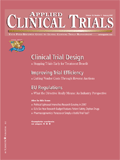eShowcase: QUMAS Compliance Closed-Loop Process
System treats compliance as a single, repeatable process to ensure organizational quality
System treats compliance as a single, repeatable process to ensure organizational quality
QUMAS (Florham Park, NJ) has released an end-to-end closed-loop compliance solution for life science companies. The QUMAS Compliance Closed-Loop Process™, which the company says is the first product of its kind in the industry, automates the tracking and management of compliance, business, and quality issues enterprise-wide.

The solution integrates various tasks with other processes critical to regulatory compliance. Rather than treating compliance as a series of silos that vary with department and/or product lifecycle stage, the Compliance Closed-Loop Process treats it as a single procedure.
The QUMAS approach automates the generation of internal or external complaints, product nonconformances, deviations, audits, investigations, and all other compliance actions. The tool captures, records, routes, and verifies completion and approvals while auditing each step in a sponsor's quality management process.
QUMAS, (800) 577-1545, www.qumas.com

Improving Relationships and Diversifying the Site Selection Process
April 17th 2025In this episode of the Applied Clinical Trials Podcast, Liz Beatty, co-founder and chief strategy officer, Inato, discusses a number of topics around site engagement including community-based sites, the role of technology in improving site/sponsor relationships, how increased operational costs are impacting the industry, and more.
Behind the Buzz: Why Clinical Research Leaders Flock to SCOPE Summit
February 7th 2025In this episode, we meet with Micah Lieberman, Executive Conference Director for SCOPE Summit (Summit for Clinical Ops Executives) at Cambridge Innovation Institute. We will dive deep into the critical role of collaboration within the clinical research ecosystem. How do we bring together diverse stakeholders—sponsors, CROs, clinical trial tech innovators, suppliers, patients, sites, advocacy organizations, investors, and non-profits—to share best practices in trial design, program planning, innovation, and clinical operations? We’ll explore why it’s vital for thought leaders to step beyond their own organizations and learn from others, exchanging ideas that drive advancements in clinical research. Additionally, we’ll discuss the pivotal role of scientific conferences like SCOPE Summit in fostering these essential connections and collaborations, helping shape the future of clinical trials. Join us as we uncover how collective wisdom and cross-industry partnerships are transforming the landscape of clinical research.